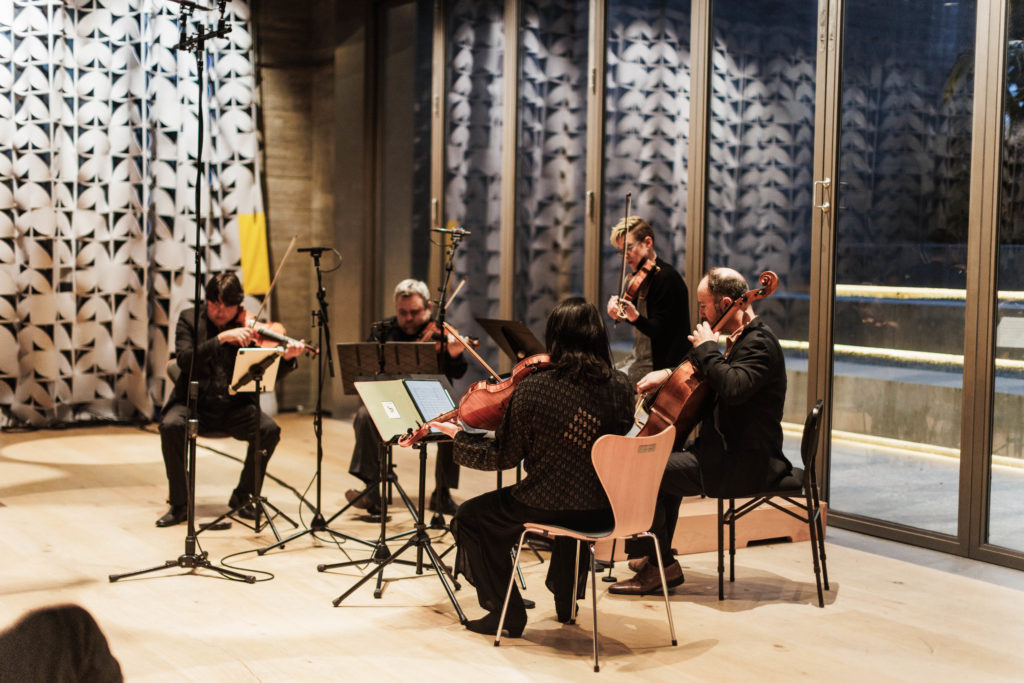Defining Home: Art of Elan’s Multicultural Discoveries
Defining Home, Art of Elan’s Sunday program presented at the Mingei International Museum, featured the Hausmann Quartet playing contemporary music of composers from starkly different traditions.

(l. to r.) Isaac Allen, Bram Goldstein, Sara Caswell, Alex Greenbaum,Angela Choong [photo (c.) Charlene Siliezar]
Shih-Hui Chen, born and educated in Taiwan, pursued her graduate education in the United States and now teaches at Rice University’s Shepherd School of Music. Her 2011 Returning Souls: Four Short Pieces on Three Formosan Amis Legends for violin solo reflects her deep roots in traditional Chinese musical culture.
Yale Strom has long been associated with the San Diego musical scene—save when he has scoured remote Central and Eastern European villages seeking out traditional Jewish Klezmer and Roma music—but he is a Detroit native, and his commissioned work Detroit–premiered at this concert—honors the three contrasting musical traditions he associates with his home city.
Although Reza Vali’s concert-opening folk song was titled Largo, Alex Greenbaum’s animated, robust cello line raced over the sustained, mellow chord progressions smartly articulated by the other members of the Hausmann Quartet. In Vali’s second folk song, titled Molto Allegro, first violinist Isaac Allen ably took over the composer’s driving, rhapsodic themes, while the quartet’s vigorous down bow strokes helped define the character of this hard-driving essay. To western ears, the structure and pulse of Persian music resembles Indian traditional music based on the raga, but I have no doubt someone raised in Persian musical culture would be able to point out important differences.
While the title of each of the three movements of Shih-Hui Chen’s Returning Souls reveals a program—the Great Flood, Head Hunting, the Glowing Maiden—it was difficult to hear these scenes in Chen’s music. Clearly, I need to listen to more Chinese traditional music. Chen’s elegantly structured movements begin with delicate ostinatos that subtly develop into extended melodic phrases. Violinist Pei-Chun Tsai’s bravura technique, her precisely sculpted articulation, and her gleaming sonority helped bridge the gap between musical cultures.
Strom’s Detroit could be described as a compact violin concerto for string quartet and solo violin. Violinist Sara Caswell triumphed in the demanding solo role, and she was well supported by the prowess of the Hausmann Quartet.
In Strom’s introduction to the performance of his work, he described the three cultures he associates with the city and geography of Detroit that he honors in Detroit’s three movements: Anishinaabe speaks to the indigenous people who lived there before European settlements; Hastings Street speaks to the city’s predominantly Jewish neighborhood, and Black Bottom salutes the city’s African-American community.
Based on my experience, Strom’s music remains unapologetically tonal, but his engaging themes are enriched and varied by the many world music cultures he has researched first hand. In Anishinaabe, the quartet’s occasional pizzicato accompaniments suggested native drumming, but more importantly, I would suggest that Caswell’s lithe lines that soared majestically above the quartet could be understood as a symbol of the freedom and harmony with nature indigenous people enjoyed.
In Caswell’s intense figurations in Hastings Street I heard echoes of the traditional Jewish cantor’s cantillation, and I thought the movement’s contrasting dance-like sections might perhaps represent festive community gatherings.
Strom gave the quartet well-defined rhythmic accompaniments in Black Bottom that connect with black music from spirituals to blues to Motown, and Caswell’s jubilant, syncopated solo themes suggested the improvisatory spirit that cannot be separated from this tradition.
This concert was presented by Art of Elan on Sunday, April 23, 2023, in the auditorium of Balboa Park’s Mingei International Museum.

Ken Herman, a classically trained pianist and organist, has covered music for the San Diego Union, the Los Angeles Times’ San Diego Edition, and for sandiego.com. He has won numerous awards, including first place for Live Performance and Opera Reviews in the 2017, the 2018, and the 2019 Excellence in Journalism Awards competition held by the San Diego Press Club. A Chicago native, he came to San Diego to pursue a graduate degree and stayed.Read more…
